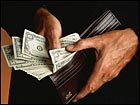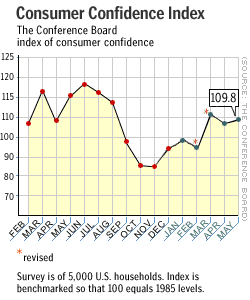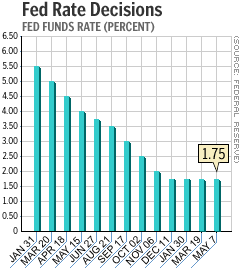
NEW YORK (CNN/Money) -
U.S. consumers, the backbone of the world's largest economy, were more confident in May, a private research firm said Tuesday, and their resilient spending on everything from computers to houses continued -- though there were also signs that they were starting to worry about the future.
The Conference Board said its index of consumer confidence rose to 109.8 in May from a revised 108.5 in April. Economists surveyed by Briefing.com expected a confidence reading of 110.
The firm's Present Situation Index, which measures consumers' attitudes about the present state of the economy, rose to 110.3 from 106.8, but the Expectations Index, measuring hopes or fears about the future, dipped to 109.4 from 109.6 in April.
"Consumers' upbeat mood about current business and labor conditions underscores the economy's continuing recovery, but the latest retreat in expectations suggest that the pace of economic growth will not accelerate in the months ahead," said Lynn Franco, Director of the Conference Board's Consumer Research Center.

But a separate report showed that another pillar of economic strength, the housing market, continued its astonishing run in April.
Existing home sales jumped 7 percent to an annual rate of 5.79 million units in April from a revised pace of 5.41 million units in March, the National Association of Realtors said in a separate report. Economists surveyed by Briefing.com expected sales at a rate of just 5.35 million units.
"Low interest rates, strong demand, high consumer confidence and an improving economy are setting the stage for another record year in existing home sales," NAR chief economist David Lereah said.
And personal spending rose 0.5 percent to $7.32 trillion after rising 0.4 percent in March, the Commerce Department said, while personal income rose 0.3 percent to $8.93 trillion after rising 0.4 percent in March. Economists surveyed by Briefing.com expected spending to rise 0.7 percent and income to rise 0.3 percent.
"Consumer spending has been surprisingly resilient, and I don't expect any kind of a drop-off," said Peter Hooper, chief U.S. economist at Deutsche Bank Securities. "But, at the same time, this is a softer report than we've been expecting, given retail sales in April."
Sales at retail stores jumped 1.2 percent in April, the government said earlier this month, the biggest gain since October 2001.
U.S. stock prices gained at the open, but retreated after investors digested the somewhat pessimistic Expectations Index in the consumer confidence report. Treasury bond prices were slightly lower.
Fed on hold
Consumer spending is closely watched by economists and policy makers since it fuels about two-thirds of the U.S. economy. Its strength -- in the face of recession, terror attacks, falling stock prices and mounting job cuts -- helped make a recession that began in March 2001 one of the shortest and mildest in history.

But economists have wondered how much longer consumers could bear the weight of the U.S. economy, with businesses continuing to cut jobs, stocks still in the doldrums, and new warnings of future terrorist attacks coming with alarming frequency.
"To get the economy growing at or above trend and to get the labor market coming back, it will take business spending picking up," Hooper said, echoing comments made by Federal Reserve Chairman Alan Greenspan.
To keep consumers spending, the Fed cut its target for short-term interest rates 11 times in 2001. It has left rates alone in 2002 and will need to start raising rates eventually to keep inflation at bay, but many economists think the central bank will wait until the labor market stabilizes.
Unemployment rose in April to 6 percent and is expected to creep even higher this year as businesses, suffering from a profit slump and skeptical about the recovery, might be reluctant to hire new workers for some time after cutting more than a million jobs in 2001.
Meanwhile, inflation gained a bit in April. The PCE price index included in the Commerce Department income and spending report -- which economists say is more closely watched by the Fed than the better-known consumer price index (CPI) -- rose 0.4 percent after rising 0.3 percent in March.
It was the biggest jump for the PCE since a gain of 0.6 percent in October 2001. Excluding volatile food and energy prices, however, the PCE index rose just 0.2 percent.
Hopeful signs
In the Commerce Department report, disposable income, or income after taxes and government fees, rose 0.3 percent after rising 0.5 percent in March. Consumers saved 2.8 percent of their disposable income in April after saving 3 percent in March. The savings rate does not include contributions to 401(k) plans, home equity, or other widespread methods of saving.
Spending on durable goods, such as cars and computers, rose 1.4 percent after falling 0.2 percent in March. Spending on nondurable goods, such as clothes and food, rose 0.8 percent after rising 0.2 percent in March.
The continued strength of the housing market, which has improved homeowners' balance sheets throughout the recession, is another hopeful sign that, despite some economists' fears, consumers aren't giving up any time soon.
"The [existing home sales] report provides even more evidence that housing is playing a critical role in the economic recovery," said NAR President Martin Edwards.
| |
 Related links
Related links
| |
| | |
| | |
|
And consumer confidence data are notoriously volatile, pointed out Conference Board economist Delos Smith, who said the slight dip in the Expectations Index in May is practically meaningless and is still considerably higher than it was a year ago.
"In May of last year, it was 87.1. In fact, before September, the highest it got was 94. Here it is sitting at [about] 110," Smith said. "That's very encouraging and positive. It's telling us the consumer is comfortable and thinks the economy will continue to look a lot like it is at this moment, and that's not that bad."
Still, it remains to be seen how much recent terror warnings by the government have damaged consumer confidence. Smith, who was optimistic that consumers would ignore the warnings and keep spending, said the effect could show up in June data or in his firm's revision of May data.

|

